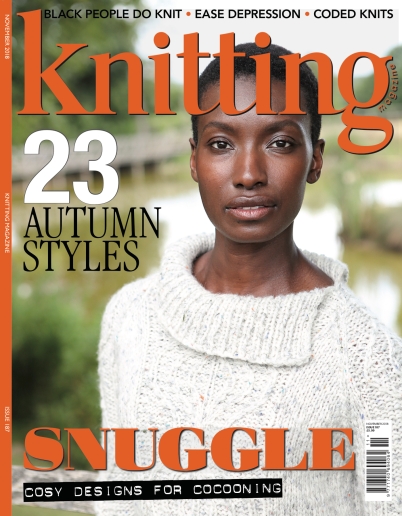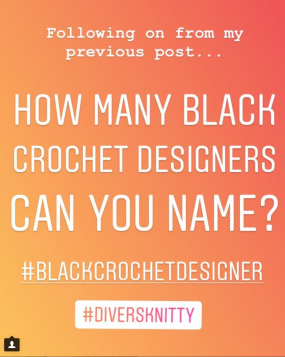I’ve been a bit quiet of late and there are a number of reasons why. First and foremost 2 weeks ago one of my very elderly parents was rushed into hospital. Thankfully they’re now recovering but obviously they had to take priority over everything else including me.
I say this not to gain sympathy although I’m truly very grateful for all the supportive DMs and comments I’ve had wishing both them and me well. It’s because I am their primary carer. That is my job.
As a result of this I’ve had a lot of catching up to do which is why I’ve only just watched THAT video on YouTube. I have no plans to link to it from here as it currently stands at over 42,000 views and I’m certainly not going to create a link that drives more traffic to it. (If you don’t know what I’m referring to you’ll need to do some work of your own by using the #notthesilentmajority #racisminknitting hashtags on Instagram, you’re sure to come to it). To be honest there’s already been so much said about it and her that I don’t think I can add to it, particularly since I’m playing catch up again. That said there are a couple of things she said that I wanted to pick up on.
‘an intense social justice issue that started infiltrating Instagram’
Firstly this phrased was used to describe the current discussions about racism in the knitting community. They’ve certainly gained traction in the last few weeks as more and more people of colour (*POC) recount and relive painful and humiliating experiences. Many of them left me open mouthed, appalled and bloody angry though I really shouldn’t be surprised. I’ve been fortunate to have had very few experiences of racism in the fibre world aside from being asked for ’n*gger brown wool for a golliwog’s hair’ (said as the customer looked up at my hair for reference) while working for Rowan as an instore Design Consultant.
Outside the fibre world I’ve had numerous experiences both subtle ‘oh your English is very good’ or ‘is it hot where you come from?’ (what, East London?) and more blatant – being called the ‘N word’ on the streets in Kent just a few years ago. Like fellow POC or anyone who has to deal with racism and discrimination let me just tell you.
Those experiences were very real for me and should I choose to talk about them no one is going to tell me that I shouldn’t. Or that talking about racism is, in itself racist. It isn’t!
Those experiences continue to be real for POC who are still being discriminated against and it will always be their/our right to talk about what they/we have experienced. They/we need to be heard and acknowledged for proper, intelligent, productive conversations to take place in order to change the fibre world into one that reflects all the people in it – minority and majority. Not just the ones who are perceived to be ‘the majority’.
As you can imagine here in the UK race isn’t a subject that’s often discussed publicly and to be honest I’ve never spoken about racism so openly and frequently before. But, as I’m no academic authority on the subject when I do, it’s as a black designer speaking purely from personal experience. So, if I’m going to do justice to my role as Keynote Speaker at this September’s Perth Festival of Yarn I’ve got a lot of reading to do. *see below
For anyone in any doubt as to whether there is racism in the knitting community. Yes, there is. Have a look at some of the experiences poc have had on @su.krita’s Instagram feed here.
Still in doubt? Well, why wouldn’t there be racism in the fibre community? It’s made up of human beings and whilst some are good, some are real shits. There are those who believe that inclusion matters. That EVERYONE is represented regardless of colour, ethnicity, gender, sexuality, physical ability or body shape while others only want to be part of a community where everyone looks and thinks like them.
The ongoing IG discussion shows that it’s just not good enough to say that it shouldn’t be discussed in the knitting community because ‘it’s full of lovely fluffy stuff’ and we’re all just here to knit. Well we are here to knit but when people (including me) are:
- asked for ’n*gger brown’ wool (I’ve never used someone’s skin tone as a colour reference)
- asked if that’s how they knit ‘where you come from?’ (again, East London?)
- constantly followed around yarn shops (well you know how ‘they’ steal)
- instantly shown the cheaper yarns (because they’re assumed to be too inexperienced to be using better, more expensive yarns)
- ignored in a yarn shop (until they spent a huge amount of money)
they / we’re entitled to share their / our experiences of racism in the knitting community because that’s where they happened.
There are many voices calling for magazine and book publishers, yarn companies and festival organisers to do better and make changes. Mine is certainly amongst them and I’m very glad to see announcements by some major names admitting that they have fallen short and need to to better. I’m not sure however that every individual silence represents a racist and I’ll no doubt get some grief for saying so. I’ve had lengthy phone conversations in the last week with two friends one of whom is black, the other white. The black friend (let’s call her AB) has spoken out about her experiences of racism and received aggressive and critical messages for doing so whilst the white friend (let’s call her CD) is concerned about saying the wrong thing but in staying quiet realises she’s perceived as part of the silent (racist) majority. The ‘silent majority’ is the second reference from THAT video that I wanted t pick up on due to its sinister connotations.
Racism isn’t a one sided issue and there needs to be room for discussion to allow people to examine both themselves and their behaviour in order to effect real change. As a fibre community we need to see more representation of POC teachers and vendors at fibre festivals and more indie dyed yarns and designs created by POC in the knitting and crochet publications we see on our shelves. Seeing yourself represented means that you are welcomed as part of that community. Some brands are doing the work now and currently implementing changes while others are just ignoring the issue in the hope that the talk will die down and those of us who have been banging on about this will simply go away. We won’t.
I’ll be continuing to highlight and promote the work of POC Designers and Crafters in the fibre community….. so it looks like I’ll be talking about it for the foreseeable future.
J x
*I am aware of the acronym for black & indigenous people of colour – BIPOC and as I do more reading to educate myself I may revise my use of POC but for now it represents people of colour in the broadest sense.




